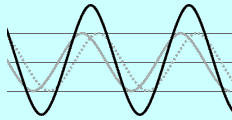|

Why are soap bubbles so colorful?
The colors of a soap bubble come from white light, which
contains all the colors of the rainbow. When white light reflects from a
soap film, some of the colors get brighter, and others disappear.
You can think of light as being made up of waves—like
the waves in the ocean. When scientists talk about waves, they
often talk about a wave's frequency. Frequency is the number of
times that a wave vibrates in a second. For ocean waves, frequency
measures the number of times a passing wave makes a surfer bob
up and down in a second. For light waves, frequency measures how
many electromagnetic vibrations happen in a second.
The frequency of a light wave determines which color light
you see. Violet light, for instance, is the highest frequency light that
you can see; it vibrates 723,000 times in a billionth of a second. White
light is made up of light waves of many different frequencies.

Two waves can be in the same place at the same time. Suppose
two ocean waves of equal size meet. Each wave pushes up and down on the
water in its path. Where the waves meet, there are two different forces
acting on the water, one from each wave. If both waves push up on the water,
the water moves twice as high as it would move if it were pushed by one
wave alone. This is called
constructive interference.
 If one wave pushes up and the other pushes
down, the two pushes cancel each other and the water doesn't move at all.
When this happens, it's called
destructive interference.
If one wave pushes up and the other pushes
down, the two pushes cancel each other and the water doesn't move at all.
When this happens, it's called
destructive interference.
What does all this have to do with the colors of bubbles?
Light waves, like water waves, can interfere with each other. A bubble
film is a sort of sandwich: a layer of soap molecules, a filling of water
molecules, and then another layer of soap molecules. When light waves reflecting
from one layer of soap molecules meet up with light waves reflecting from
the second layer of soap molecules, the two sets of waves interfere. Some
waves add together, making certain frequencies or colors of light brighter.
Other waves cancel each other, removing a frequency or color from the mixture.
The colors that you see are what's left after the light waves interfere.
They're called
interference colors.
The interference colors depend on how far the light waves have to travel
before they meet up again--and that depends on the distance between the
layers or the thickness of the soap film. Each color corresponds to a certain
thickness of the soap film. By causing the liquid bubble film to flow and
change in thickness, a puff of wind makes the bubble colors swirl and change.
The very thinnest film—one that's only a few millionths of an inch thick—looks
black because all the reflecting wavelengths of light cancel.
When the soap film looks black, it's just about to pop.
What's the best set-up for seeing colors in a bubble?
Interference colors on a bubble look brightest when there's white light
shining on the bubble and a black background behind it. The colors come
from light that's reflecting from the soap film. You want to be on the same
side of the bubble as the light source so that light will bounce back to
your eyes. The black background keeps light that's shining through from
the other side of the bubble from washing out the colors.
Where else can I see shimmering colors like these?
You can experiment with interference colors using the
Reflecting
Rainbows
experiment online, or the Rainbow Prints experiment in the
Science Explorer Book.
|